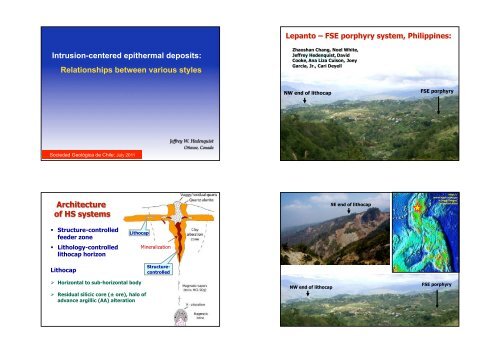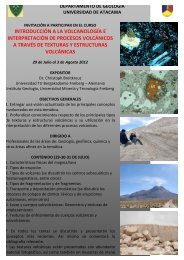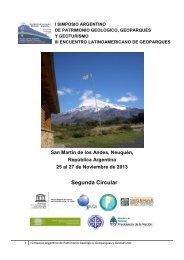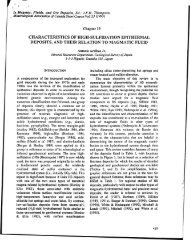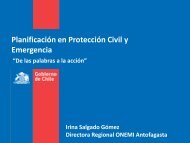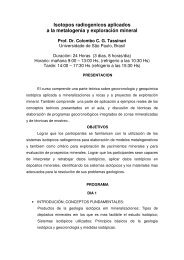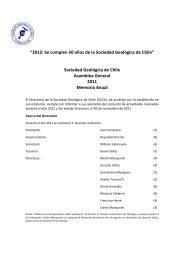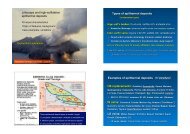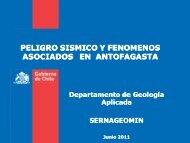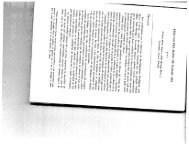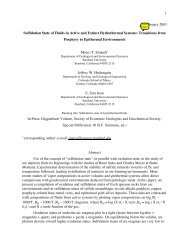Lithocap Structure-controlled feeder zone Lithology-controlled ...
Lithocap Structure-controlled feeder zone Lithology-controlled ...
Lithocap Structure-controlled feeder zone Lithology-controlled ...
You also want an ePaper? Increase the reach of your titles
YUMPU automatically turns print PDFs into web optimized ePapers that Google loves.
Zhaoshan Chang, Noel White,<br />
Jeffrey Hedenquist, David<br />
Cooke, Ana Liza Cuison, Joey<br />
Garcia, Jr., Cari Deyell<br />
NW end of lithocap<br />
FSE porphyry<br />
Sociedad Geológica de Chile: July 2011<br />
SE end of lithocap<br />
http://<br />
www.ngdc.noaa.go<br />
v/mgg/image/<br />
2minrelief.html<br />
" <strong>Structure</strong>-<strong>controlled</strong><br />
<strong>feeder</strong> <strong>zone</strong><br />
" <strong>Lithology</strong>-<strong>controlled</strong><br />
lithocap horizon<br />
<strong>Lithocap</strong><br />
<strong>Lithocap</strong><br />
Mineralization<br />
<strong>Structure</strong><strong>controlled</strong><br />
! Horizontal to sub-horizontal body<br />
! Residual silicic core (± ore), halo of<br />
advance argillic (AA) alteration<br />
NW end of lithocap<br />
FSE porphyry
Cretaceous-<br />
Paleogene<br />
Lepanto<br />
metavolcanics<br />
12-13 Ma Bagon<br />
intrusive complex<br />
Late Oligocene to mid-<br />
Miocene Apaoan<br />
volcaniclastics<br />
Slightly younger Balili<br />
volcaniclastics<br />
Qtz diorite<br />
1 km<br />
porphyry<br />
Imbanguila<br />
dacite<br />
Imbanguila<br />
pyroclastics<br />
(3.3-1.8 Ma)<br />
Qtz diorite<br />
1 km porphyry<br />
Cretaceous-<br />
Paleogene<br />
Lepanto<br />
metavolcanics<br />
12-13 Ma Bagon<br />
intrusive complex<br />
Late Oligocene to mid-<br />
Miocene Apaoan<br />
volcaniclastics<br />
Slightly younger Balili<br />
volcaniclastics<br />
porphyry<br />
(3.3-1.8 Ma)<br />
Pliocene<br />
volcanism<br />
3.3 - 1.8 Ma,<br />
multiple eruptions<br />
Imbanguila<br />
dacite<br />
Imbanguila<br />
pyroclastics<br />
(3.3-1.8 Ma)<br />
Qtz diorite<br />
1 km porphyry<br />
Cretaceous-<br />
Paleogene<br />
Lepanto<br />
metavolcanics<br />
12-13 Ma Bagon<br />
intrusive complex<br />
Bato pyroclastics<br />
(1.2 Ma)<br />
Bato dacite<br />
porphyry (1.2 Ma)<br />
Lapangan Tuff<br />
(0.19 Ma)<br />
Late Oligocene to mid-<br />
Miocene Apaoan<br />
volcaniclastics<br />
Slightly younger Balili<br />
volcaniclastics<br />
porphyry<br />
(3.3-1.8 Ma)<br />
Young<br />
cover:<br />
50 ppb Au<br />
X Small<br />
workings<br />
Breccias<br />
NW end of lithocap:<br />
qtz-alunite cliffs at<br />
unconformity, with<br />
kaolinite halo<br />
Buaki<br />
porphyry<br />
Lepanto HS:> 0.9<br />
Mt Cu & 102 t Au<br />
FSE porphyry:<br />
650 Mt @ 0.65%<br />
Cu & 1.2 g/t Au<br />
<strong>Lithocap</strong><br />
geometry<br />
and base of<br />
the<br />
Imbanguila<br />
units<br />
Victoria veins, 11<br />
Mt @ 7.3 g/t Au +<br />
Ag-Cu-Pb-Zn<br />
Teresa veins, 0.8<br />
Mt @ 5.74 g/t Au<br />
1 km<br />
Nayak veins<br />
Mohong Hill<br />
porphyry + HS<br />
Guinaoang<br />
porphyry, 500<br />
Mt @ 0.4% Cu<br />
& 0.4 g/t Au<br />
Contour of the<br />
Imbanguila base from<br />
Garcia (1991)
Mankayan district, Philippines<br />
Mohong Hill<br />
quartz-alunite<br />
lithocap<br />
Lepanto fault<br />
Looking NNW<br />
Most ore<br />
(~70%) in<br />
root <strong>zone</strong> of<br />
lithocap, in<br />
Lepanto fault<br />
or its splay<br />
branches<br />
Dickite ± kaolinite<br />
Lepanto<br />
fault<br />
Quartz-alunite<br />
Dickite ± kaolinite<br />
Hedenquist et al., 1998; Chang et al., 2011<br />
Hedenquist et al., 1998;<br />
Chang et al., 2011
1.41 Ma<br />
1.35 Ma<br />
1.42 Ma<br />
FSE – Lepanto alteration:<br />
Coupled potassic and quartz-alunite<br />
(lithocap), later phyllic overprint<br />
Early alteration:<br />
AA: Quartz – alunite – pyrite ±<br />
pyrophyllite ± diaspore ± dickite ±<br />
kaolinite lithocap<br />
Locally silicic: Vuggy quartz – pyrite<br />
Later mineralization + silicification<br />
! Pyrite<br />
! Pyrite, enargite, luzonite<br />
! Tennantite, chalcopyrite, sphalerite,<br />
galena, tellurides, selenides, native Au<br />
Hedenquist et al., 1998<br />
Gonzalez, 1959; Tejada, 1989; Claveria, 1997, 1998, 2001<br />
Early convecting magma,<br />
rapid crystallization =<br />
High rate of fluid advection, fluid<br />
rises rapidly with little cooling,<br />
and intersects its solvus<br />
High-temperature, ductile<br />
conditions at shallow depth<br />
Brine forms deep potassic <strong>zone</strong>,<br />
vapor separates from brine and<br />
discharges through ductile <strong>zone</strong>:<br />
part of vapor condenses near<br />
the surface to acidic liquid,<br />
creating lithocap<br />
Shinohara & Hedenquist, 1997
Early convecting magma (30 -<br />
50 % crystals), flux ~ equal to<br />
White Island quiescent eruption<br />
Later stagnant magma,<br />
slow crystallization =<br />
Low rate of fluid advection, fluid<br />
rises slowly and loses heat, such<br />
that it does not intersect solvus<br />
Lower temperature, brittle<br />
conditions at shallow depth<br />
Late stagnant magma (>50%<br />
crystals, advective flux sharply<br />
decreases ~ 10x<br />
Creation of the phyllic<br />
(muscovite, “sericite”) stage<br />
Shinohara & Hedenquist, 1997<br />
Effect on fluid exsolution,<br />
advection, and nature of fluid<br />
ascent?<br />
Early magmatic fluid =<br />
Hot, plastic, lithostatic P (potassic,<br />
A veins)<br />
Rapid ascent, intersection of<br />
solvus, forms brine plus vapor<br />
Later magmatic fluid =<br />
Cooler, brittle, hydrostatic P<br />
(muscovite, D veins)<br />
Critical fluid never intersects<br />
solvus due to slow ascent and<br />
cooling<br />
Normal progression of exsolving<br />
magma chambers, magma<br />
convection early (fast<br />
crystallization), to later stagnant<br />
xstallization (conductive heat loss)<br />
Shinohara and Hedenquist, 1997;<br />
Hedenquist et al., 1998<br />
Chang et al., 2011
- Related to Na content<br />
Chang et al., 2011<br />
Higher Na/(Na+K) ratio<br />
indicates higher formation<br />
temperature (Stoffregen<br />
and Cygan, 1990)<br />
Milagros: Garcia, 2009<br />
Chang et al., 2011<br />
Whole rock<br />
Cu
Decrease:<br />
Alunite Pb, Ag/Au<br />
Whole-rock (alunite-bearing only): Pb, Ag, Ag/Au, Hg<br />
Lepanto<br />
FSE porphyry<br />
Lepanto<br />
Victoria veins<br />
500 m<br />
FSE<br />
Surface projections of<br />
Victoria-Teresa IS vein &<br />
Lepanto HS enargite, over<br />
Far Southeast porphyry<br />
Alunite<br />
1.40-1.45 Ma<br />
Enargite-Au<br />
IS Au-Ag veins<br />
Teresa<br />
veins<br />
Bt 2.2-1.8 Ma<br />
Porphyry Cu<br />
Hydro Biot<br />
1.40-1.45 Ma<br />
Illite ~1.35 Ma<br />
X Horn<br />
1.45 Ma<br />
X Biot<br />
1.18 Ma<br />
X Illite<br />
1.4-1.15 Ma<br />
Hedenquist et al., 2001
Weak smectite + pyrite,<br />
illite-smectite + pyrite at<br />
lower elevation<br />
DNK: dickite, nacrite, kaolinite,<br />
or any combinations<br />
iX: illite crystallinity<br />
DNK: dickite, nacrite, kaolinite, or any combinations<br />
Upward flare of leaching due to cooling; hydraulic gradient<br />
caused offset of lithocap (and ore) from causative intrusion<br />
Hedenquist et al., 1998; Hedenquist and Taran, 2011
Modified from values compiled<br />
by B. Gemmell, in prep.<br />
Billion $ (US)<br />
25!<br />
17!<br />
8.5!<br />
Ag $!<br />
Au $!<br />
M: Mexico<br />
Au $700 US/oz<br />
Ag $10 US/oz<br />
D: diatreme related<br />
Intermediate<br />
sulfidation<br />
D<br />
N=12<br />
M D<br />
M<br />
D<br />
M<br />
M<br />
D<br />
M<br />
Low sulfidation<br />
LS (alkalic)<br />
N=6<br />
~5 Moz Au eq.<br />
N=4<br />
D<br />
0!<br />
Baia<br />
Creede!<br />
Mare!<br />
Mt<br />
Aurora!<br />
Muro!<br />
Sacarimb!<br />
Aracata!<br />
Victoria!<br />
Gunung<br />
Tonapah!<br />
Pongkor!<br />
Fresnillo!<br />
Kelian!<br />
San Cristobal!<br />
Comstock<br />
Zacatecas!<br />
Lode!<br />
Rosia<br />
Beregovo!<br />
Montana!<br />
Tayotita!<br />
Guanajuato!<br />
Baguio!<br />
Pacucha-Real!<br />
Sunnyside!<br />
Milos!<br />
Golden Cross!<br />
Profitis Mogollon! Illias!<br />
Cracow!<br />
El Bronce!<br />
Karangahake!<br />
Ovacik!<br />
Takatama!<br />
Baia<br />
Gosowong!<br />
Mare!<br />
Lebong<br />
Perama!<br />
Tandai!<br />
Thames!<br />
Kushikino!<br />
Bodie!<br />
Oatman!<br />
Montana<br />
Bullfrog!<br />
Tunnels!<br />
Konomai!<br />
Sleeper!<br />
El Limon!<br />
Republic!<br />
Misima!<br />
Pajingo!<br />
McLaughlin!<br />
Midas!<br />
Esquel!<br />
El Penon!<br />
Cerro Vanguardia!<br />
Hishikari!<br />
Waihi!<br />
Round<br />
Baley!<br />
Mtn!<br />
Emperor!<br />
Porgera!<br />
Cripple<br />
Ladolam!<br />
Creek!<br />
100 Au<br />
Au-Ag (LS)<br />
Au-Te (alkalic)<br />
Ag-(Au)-Pb-Zn (IS)<br />
Au-Cu (HS)<br />
Geologic setting of intermediate- (and low-)<br />
sulfidation vein deposits (Americas, SW Pacific)<br />
<br />
LS: Rhyolite-basalt association in extensional settings:<br />
Intra, near, and backarc; postcollision rifts (non porphyry)
S Kyushu, looking south<br />
Kushikino: Mt Kamuridake to east<br />
capped by silicic <strong>zone</strong>s, adv. argillic halos<br />
Tectonics determine<br />
type of epithermal Au<br />
deposits (early HS, IS,<br />
later LS)<br />
Kushikino IS veins:<br />
qtz-calcite-Au<br />
migration<br />
of volcanism<br />
Kushikino IS<br />
veins 2 km west
OR, perched, barren lithocap, marginal intermediate sulf’n veins<br />
2 km<br />
barren<br />
Muscovite halo, Ag-Au w/ spl, ccp, tn<br />
2M mica<br />
Hudson<br />
(2003)
Dietrich et<br />
al., 2007<br />
1 km<br />
14.7-14.1 Ma<br />
13.7 Ma<br />
13.5 Ma<br />
COLQUIJIRCA MINE<br />
Modified from Petersen & Vidal (1996)
15.4-14.5 Ma<br />
14.5-14.4 Ma<br />
Colquijirca mine, Cerro de Pasco district, Merced pit (to north)<br />
S N<br />
Cerro Marcapunta<br />
Marcapunta<br />
Norte<br />
Enargite-py, cc-cv-dg<br />
Dacite flow dome<br />
Fontbote & Bendezu (1999)<br />
Bendezu et al., 2008
N<br />
Marcapunta Oeste<br />
Marcapunta Norte<br />
Dome - diatreme<br />
Smelter: pyrite + enargite<br />
Cerro Marcapunta: dacite<br />
Colquijirca<br />
Bendezu et al., 2008<br />
Alto Chicama, Peru<br />
Andean arc, Peru:<br />
75 Moz in HS deposits<br />
2001, discovery 2 km from<br />
road in mining district<br />
10 S<br />
2003, 10.5 Moz resource<br />
64 N<br />
ARUNTANI<br />
Ref: Colquijirca mine staff (Fontbote & Bendezu, 2000)<br />
Bendezu et al., 2008
Dante Loayza and Jorge Barreda (Aruntani SAC),<br />
Alvaro Crósta, Wolfgang Morche, and Jeffrey Hedenquist
Canahuire resource model & pit shell: Chucapaca JV<br />
W<br />
E<br />
Erosion level?<br />
1.3 km<br />
350 m<br />
Mineralisation<br />
g/t Au<br />
Open<br />
700W<br />
300W<br />
Looking North<br />
100E<br />
Muscovite up to<br />
pyrophyllite


